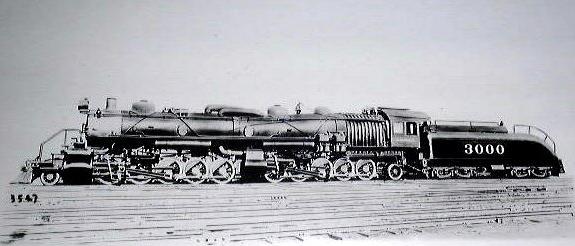We have to remember this was before they really understood the power of the large firebox…

The size of the 2-10-10-2 firebox is miniscule even compared to the later Santa Fe 2-10-2 firebox…

We have to remember this was before they really understood the power of the large firebox…

The size of the 2-10-10-2 firebox is miniscule even compared to the later Santa Fe 2-10-2 firebox…

someone a few months ago acquired a 2-10-10-2 brass ho model ,it was sweeeet im gonna look on FB ho pages &see if i can flush him out
[quote user=“Dr D”]
SANTA FE AND THE ARTICULATED LOCOMOTIVE
Alfred Bruce, Director of Steam Locomotive Engineering at American Locomotive Company ALCO comments that the first Mallet compound articulated engines were constructed in the United States in 1903 and 1904 by ALCO for the Baltimore & Ohio. This was 16 years after the European railroads which developed and used the Mallet compounds in considerable quantity.
Baldwin Locomotive Company built its first Mallet compound in 1906 as a 2-6-6-2 for the Great Northern Railway as a road engine. The 2-6-6-2 was by far the most built articulated engine in American railroad history. So popular that it was built until the end of steam locomotive construction in 1949 when C&O 1304 was constructed new by Baldwin. C&O 1304 is currently under restoration by Western Maryland Senic Railroad today.
Baldwin followed this design with the 2-8-8-2 for the Southern Pacific in 1909. This was also to prove to be another extremely popular locomotive wheel type. Not to be outdone with these successes and the articulated compound Mallet craze, Baldwin built for the Erie Railroad in 1914 several triplex engines. The infamous 2-8-8-8-2 type 6 cylinder tank locomotives of which only 3 were ever built.
In the midst of this Mallet compound craze in America the Atchison Topeka & Santa Fe jumped in with both feet in 1909 with the construction of “Prairie Mallets” from Baldwin of which were two 4-4-6-2 passenger compounds and two 2-8-8-2 helper compounds. Santa Fe touted the long rigid boiler, 73 inch drivered speedsters as the “largest and most powerful passenger locomotives in existance.” First numbered ATSF 1300-1301 this was later changed to ATSF 1398-1399.
George Henderson, who was responsible for the Triplex design, actually did consider Quadruplex and Quintuplex designs. I’m sure that they would have run out of steam before they even moved their own length.
I’d like to add a couple of comments to “Doc’s” notes. The Santa Fe had a total of 64 2-6-6-2 compound mallets built in 1910-1911 numbered in the 1100 and 3300 series. Numbers 1157, 1158 and 1159 had jointed boilers , as did numbers 3320 through 3323. All the rest had rigid boilers. Even with 69-inch drivers, they were not intended for passenger service but for freight service across the plains of New Mexico and Texas where they served well until replaced by the 3800 class 2-10-2s. As to the 2-10-10-2s, they were numbered 3000 thru 3009 and worked west from Winslow, Arizona to San Bernardino, California during their very short career. He is incorrect in naming “Santa Fe Big Three” as shown. Truly, the height of Santa Fe steam development was the 1938 4-6-4, 4-8-4 and 2-10-4, but in the environs of Topeka, the terms “Hudson”, “Northern” or “Texas” were never spoken.
MrAT&SF
The low pressure cylinders on the VGN 800-series 2-10-10-2s were 48 inches in diameter. To my knowledge, they are the largest cylinders in a railroad steam locomotive. They and several other parts had to be removed for shipment to the VGN because of clearance restrictions.
I trust that wanswheel or someone like him who knows how to access the original magazine photograph will provide a link to the very informative ‘front view’ of the low-pressure cylinders, so you can appreciate just how large 48" cylinders with adequately strong construction and lagging could be on standard gauge. In the meantime, here is a brass model in 3/4 view:

Wow 48" is huge. That could be a dinner table.
Virginian 2-10-10-2




Is it just perspective in the photos or are those 48" cylinders larger than the driving wheels to which they are attached??
They were close the drivers where 56" in diameter.